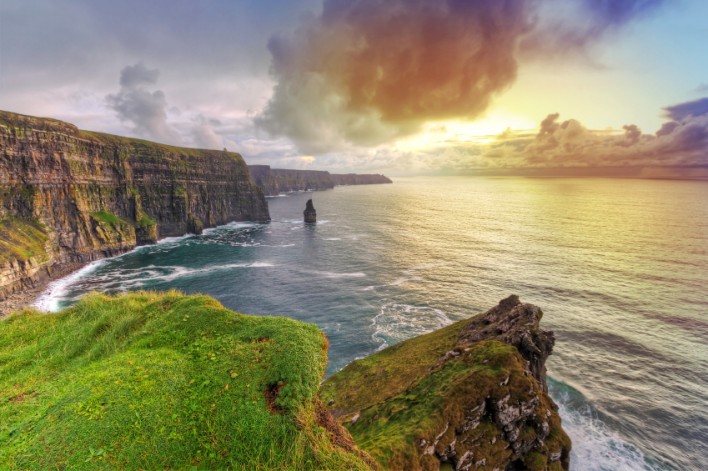Blog Categories
Blog CategoriesOne Million Reasons To Visit the Cliffs of Moher
The one millionth visitor was recorded last October to the Cliffs of Moher, marking the first time that this milestone figure was reached at the world-famous County Clare visitor attraction.
 |
| The Cliffs of Moher |
Rita Shaw from Florida, USA was surprised to find out that she was the one millionth person to visit when she arrived at the Cliffs with her husband Stephen to be greeted by champagne and prizes on October 20th 2014.
The Cliffs of Moher is Ireland’s most visited natural attraction and is now part of the Wild Atlantic Way. Standing 214m (702 feet) at the highest point, they stretch for 8km (5 miles) along the Atlantic coast.
On a clear day, there are views as far as the Aran Islands and Galway Bay as well as the Twelve Pins and Maum Turk mountains in Connemara plus Loop Head to the south and even the Dingle Peninsula and Blasket Islands in Kerry.
O’Brien’s Tower is one of the focal points and stands at the highest point, serving as a viewing post for visitors for hundreds of years.
This world class visitor experience has kept the crowds coming and this magical place dates back at least two thousand years. The name is said to come from a 1st Century BC fort that was originally sited where the Moher Tower now stands. The old Irish word ‘Mothar’ means ‘ruined fort’.
There are many extraordinary legends around the Cliffs of Moher including the Mermaid of Moher; the Corpse Eating Eel; The Hag and Cu Chulainn; The Lost City of Kilstiffen and the Leap of the Foals. The area has inspired folklore and stories for generations and it was an important location in the sighting of the ships from the Spanish Armada in 1588.
The famous Liscannor Stone also has a big association with the Cliffs of Moher. The flagstone was quarried in the area leading to a substantial industry in the 19th and early 20th century, but after World War 1 the mines closed. There are, however, a small number of mines in the area still producing the famous stone.
A new state of the art visitor center opened in 2007 transforming facilities for tourism in the area. The Cliffs of Moher Visitor Experience is the culmination of 20 years of work and is an underground building and exhibition space.
Ecological restoration and reconstruction of the grassland habitats of the cliff tops was a big part of the recent Visitor Center project. The Cliffs of Moher form part of the Burren and Cliffs of Moher Geopark which was awarded membership of the UNESCO supported Global Geoparks Network in 2011.
The rocks that make up the Cliffs of Moher were formed a staggering 300 million years ago. Bands of sandstone, shale and siltstone can be seen and there is also a sedimentary basin on view here that is normally only visible under the sea.
Coastal erosion remains a big threat to the Cliffs with waves crashing and causing sections of the cliff face to regularly collapse in to the sea under their own weight.
One of the most exciting views at the Cliffs is the much-photographed great sea stack (Branaunmore) at the foot of the cliffs which stands 67 meters high. There is also a large sea arch at Hag’s Head and many smaller sea arches below the Napoleonic signal tower. Some of these caves featured in the film Harry Potter and the Half Blood Prince. For surfers, the Cliffs of Moher is also the location of ‘Ireland’s perfect wave’ – Aileen’s Wave – featured in the film Waveriders.
The rock layers are rich in fossil formations and geologists around the world agree that the Cliffs of Moher is one of the most important natural wonders in the world!
